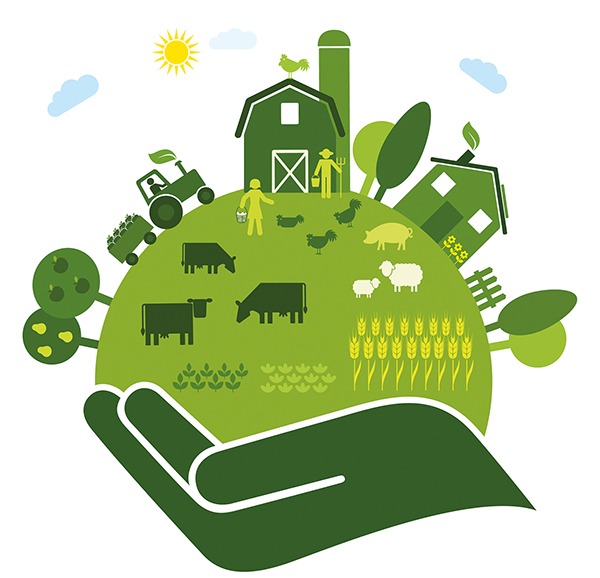By Rod MacRae, Elisabeth Abergel and Mustafa Koc
Traditional approaches to food and agriculture policy making in Canada are in question, with the realization that government policy goals, institutional arrangements and instruments are insufficient. Below, Rod MacRae, Elisabeth Abergel and Mustafa Koc consider the evolution of sustainable food systems, and argue for changes in the policymaking process.
The traditional approaches to food and agriculture policy making in Canada are in question, and this volume sets out to identify new ways for nonstate actors to influence the evolution of sustainable and health-promoting food systems. Chronic food system problems remain unresolved, with many still unaddressed. There have only been modest improvements in some agri-environmental conditions, while others such as greenhouse gas emissions and nutrient contamination of waterways continue to worsen.1 National farm finances have generally been poor for years, complicating the challenges of helping the farm sector move towards more sustainable production systems. The food system, it seems, is increasingly implicated in creating the conditions compromising human and environmental health. The nutritional health of Canadians continues to deteriorate, with rising obesity levels serving as the most acute indicator of nutrition policy and programme failures. Food bank use is not coming down significantly, and some 10% of the Canadian population remains unable to acquire a nourishing diet at an affordable price.2 Food safety scares are now regular occurrences and consumers are increasingly disenchanted with the ways in which the Canadian food supply is being managed. These tendencies are exacerbated by the entrenchment of food and agricultural policy making in ineffective and unresponsive, and somewhat closed, institutional networks.
Many blame broad structural forces within the capitalist food economy for the current state of affairs, with the unsuccessful efforts of governments to curb the negative effects of these forces a significant contributing measure. It can be argued that states are responsible for establishing the structure of the global food system, including its financialization, with its incentive to expand a productivist export-oriented agricultural agenda. With increasingly complex problems has come the realization that traditional Canadian government policy goals, institutional arrangements and instruments are insufficient. Earlier eras of state regulation revolved around a productivist paradigm that worked well when the state had significant capacity, the issue was targeted, but the policy actors were recalcitrant.3 But in the neo-liberal era of bilateral and multilateral trade arrangements and international institutions, many of the traditional policy and regulatory tools have been removed, replaced in some cases by new policy orientations that reflect changing trends. More dramatically, it appears as though some states have given up their capacity to determine national priorities due to international trade commitments. Some may have deregulated their capacity to respond to local or regional agri-environmental pressures. Governments are searching for new and effective regulatory instruments that might work without unduly straining apparently limited human and financial resources.4 Food and agricultural policy themes are acutely affected by this reality, by the complexities of the subject, by larger shifts in the loci of the state’s decision making, and by the new prominence of health concerns related to food.
New Spaces for Political Involvement
Although many critics point to governance gaps in the global economy, it has become clear that these gaps have opened up new spaces for political involvement by civil society actors eager to advance a fuller set of policy goals and effect change in the food system. However, these civil society actors, although looking for alternative approaches that might have greater chance of solving problems, have been slow to realize that shifts are underway within the state and have not necessarily recognized the opportunities and challenges inherent to government efforts to find “next generation” policy and regulatory instruments. In Canada, the slow response time by non-governmental actors has been blamed on a weak civil society sector lacking strong institutional and organizational capacity, as well as on a clientelist policy environment that prevents meaningful political participation by concerned groups and/or individuals. Nonetheless, as this volume demonstrates, there is sufficient, if not ideal, capacity to exert influence in a newly configured policy context.
Sustainable food systems use design and management procedures that work with natural processes to conserve all resources, promote agro-ecosystem resilience and self-regulation, minimize waste and environmental impact, while maintaining or improving farm profitability. Such systems improve the condition of the natural resources on which they depend and the health of those consuming [their] products[.]5
then no Canadian governments have embraced such significant changes.6 The Agricultural Policy Framework, first implemented in 2003 and renewed in 2008/09,7 reflects an awareness that there are significant environmental issues to be addressed especially to maintain Canada’s international reputation for agri-environmental performance, but the series of programmes implemented to date are only having a very modest impact.8 Moreover, new programs, such as investments in biofuels, may actually have more detrimental environmental and economic impacts over the long term.
Sustainability and Health
Civil society, and some farm organizations, has been pushing for progressive implementation of new approaches, potentially leading to broad paradigmatic changes in the food and agriculture system, ones that reflect a focus on sustainability and health (and even multi-functionality). But are they having an effect? Although these CSOs may be blunting some of the efforts of neo-liberal agricultural actors to push policy makers to embrace even more significant free trade frames, such forces could equally push the system away from sustainability and more towards further trade liberalization, with its many attendant challenges for sustainability and health. And some CSOs may inadvertently be contributing to the reinforcement of neo-liberal frames, caught in service responses to the voids created by state contraction of welfare and related functions as in the case of food banks. In many ways, CSOs are trying to fill political gaps by working outside of traditional institutional networks, strengthening their own capacity but with the unintended consequence of justifying the lack of state intervention around issues of agriculture and environment. Nevertheless, it seems that there are missed opportunities for CSOs to translate their concerns about food and agriculture policy, and the ways it is conspiring to damage human and environmental health, into effective state policies.
It is clear that new forms of governance are emerging – but not necessarily for desirable reasons or with effective conception and implementation. Although a variety of these new governance approaches have been described in the literature (see, for example, Gunningham9), in the view of the contributors to this volume, most rely excessively on voluntary and private sector initiatives to be successful. A guiding premise of this volume is that a governance regime that embraces a wide range of coordinated and integrated instruments (including some traditional command and control regulations), well matched to the desired effect and implemented by an equally wide range of state and non-state actors, may have the best chance of success in the long run. Such an approach has sometimes been referred to as regulatory pluralism10 or, on the instrument side, a “symphony” approach to effecting change.11
Roadblocks at all Levels
But adapting to these new approaches represents a significant challenge for governments and CSOs. CSOs have tended to define their role as primarily an extra-parliamentary one, trying to influence political actors sufficiently to change legislative development, parliamentary reports and voting patterns. At one point this was a sensible strategy, given that the government is supposed to make policy and Parliament’s role is to hold government to account for its activities. But Parliament’s capacity to do this has somewhat eroded in the era of neo-liberal restructuring and “governing from the centre” 12, challenging the foundation of CSO strategy. Numerous forces have pushed Parliament away from substantive policy critiques and solutions. It would seem government legitimacy is eroding, along with its potential to deal with complex policy problems that deserve substantial oversight.
It is now unlikely that a complex, multidimensional and multi-departmental food policy issue would undergo substantive Parliamentary discussion, due to roadblocks at all levels.13 Such policy is unlikely to be a priority of the Prime Minister’s Office (PMO). Cabinet participation in policy making has been eroded, so that agriculture or health ministers are not likely to bring forward significant food and agriculture legislation without PMO approval.14 This has effectively removed many potential levers of action for CSOs directly involved in the issues.
Resistance to Change
It is also important to recognize that many governmental bureaucracies tend to support the status quo, rather than tackling complex files in a substantive way. These change-resistant tendencies typically include: avoidance of contentious out-of-the-box initiatives; emphasis on crisis management; reluctance to allocate sufficient resources to programs; secrecy and confidentiality; and avoidance of public and parliamentary scrutiny. Issues addressed are frequently those with electoral implications, leaving many substantive, but less visible, issues unattended.
It is also true that increasingly states must coordinate policy efforts with international and supranational bodies, altering both the capacity of governments to respond effectively in specific areas and thus removing the strategic focus of CSO actions. Hence, the changing policymaking context demands innovative approaches and a greater role for national and sub-national actors in the process.
Reprinted by permission of University of British Columbia Press. Excerpted from Health and Sustainability in the Canadian Food System: Advocacy and Opportunity for Civil Society by Rod MacRae and Elisabeth Abergel. Copyright 2013. All rights reserved.
About the Authors
Rod MacRae is an associate professor of food policy in the Faculty of Environmental Studies at York University.
Elisabeth Abergel is a professor in the Sociology Department and a member of the Institut des Sciences de l’Environnement at the Université du Québec à Montréal.
Mustafa Koc is a professor of sociology at Ryerson University Toronto.
References
1. Lefebvre, A. et al. eds, Environmental Sustainability of Canadian Agriculture, Report #2 (Ottawa: AAFC, 2005).
2. Food Banks Canada, Hunger Count 2009 (Toronto: Food Banks Canada, 2009).
3. Howlett, M. “What is a Policy Instrument? Policy Tools, Policy Mixes and Policy Styles” in Designing Government: From Instruments to Governance, ed. P. Eliadis et al, (Montreal and Kingston: McGill Queen’s University Press, 2005), 31-50.
4. Gunningham N., “Reconfiguring Environmental Regulation” In Designing Government: From Instruments to Governance, 333-352.
5. Adapted from MacRae, R.J., S.B. Hill, J. Henning and A.J. Bentley, “Policies, Programs And Regulations To Support The Transition To Sustainable Agriculture In Canada.” American J. Alternative Agriculture, 5, 2 (1990):76-92.
6. For details see MacRae, R.J., “This Thing Called Food: Policy Failure in the Canadian Food and Agriculture System,” in For Hunger-proof Cities: Sustainable Urban Food Systems, ed. M. Koc et al. (Ottawa: International Development Research Centre and the Ryerson Centre for Studies in Food Security, 1999), 182-194; MacRae, R.J. and the Toronto Food Policy Council, “Not Just What, But How: Creating Agricultural Sustainability and Food Security by Changing Canada’s Agricultural Policy Making Process.” Agriculture and Human Values, 16 (1999): 187-201.
7. The framework’s second 5 year version, Growing Forward, is in the process of being implemented.
8. In truth, very few Canadian agri-environmental programmes have been properly evaluated.
9. Gunningham, “Reconfiguring Environmental Regulation”, 333-352.
10. Gunningham, “Reconfiguring Environmental Regulation”, 333-352.
11. Winfield, M., “An Unimaginative People: Instrument Choice in Canadian Environmental Law and Policy”(10th Annual Saskatchewan Environmental Law Review lecture, Saskatoon, Oct 15, 2007).
12. Savoie, D.J., Government from the Centre: The Concentration of Power in Canadian Politics. (Toronto: University of Toronto Press, 1999); Savoie, D.J., Breaking the Bargain: Public Servants, Ministers and Parliament (Toronto: University of Toronto Press, 2003).
13. Note that more limited and highly politically charged issues, such as the fate of the Canadian Wheat Board, are still occasionally part of Parliamentary debate.
14. Savoie, Government from the Centre.
15. Savoie, Breaking the Bargain.
































































